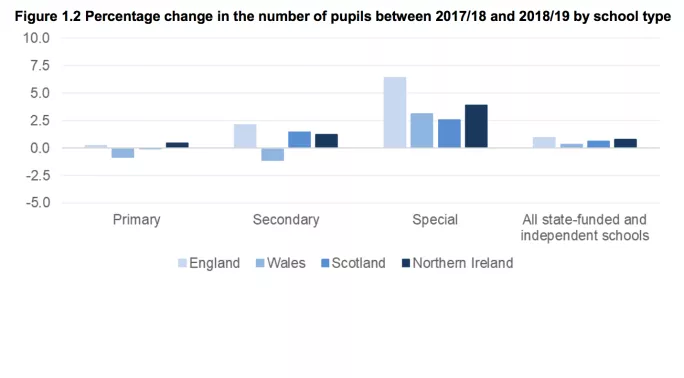The numbers of pupils attending special schools increased by more six cent in the past year according to new government figures.
The Department for Education tables published today show the sharp rise in pupils attending SEND state schools in England 2018/19 compared with 2018/17. But the overall school population increased by just one per cent.
Background: MPs report warns system is in crisis
Quick read: Five facts about SEND education
Inspection: Call for mainstream schools to face new SEND inspection checks
The rise in state special school pupils in this country was a larger increase than was seen in Scotland, Wales or Northern Ireland.
Figures also show the number of pupils attending state special schools in England has seen a continuous rise for at least six years.
According to the DfE data there was 107,900 pupils in special schools in 2012/13 in a national cohort of 9,198,100 in state schools.
This has risen every year to 139,500 attending a special school by 2018/19 in a national cohort of 9,831,600 state school pupils.
In addition there were 3,700 pupils attending independent special schools in 2018/19 up slightly from 3,600 in 2017/18.
Earlier this year the FFT Education Datalab highlighted how the proportion of pupils with statements/EHCPs attending special schools has been increasing since 2007 .
And DfE figures earlier this year revealed that the number of pupils with SEND has risen for the third year in a row - meaning there are now 1.3 million pupils with SEND - 14.9 per cent of all pupils.
Figures showed that there were 1,044 state-funded and non-maintained special schools in England in January 2019. This compares to 1,033 in January 2018 and 971 in January 2011.
The most common type of primary need among pupils with SEND is speech, language and communication needs which account for more than one in five (22 per cent) of pupils with SEND that have this as their primary need.
Speech, language and communication needs are also the most common need among pupils on SEN support: 23 per cent of pupils on SEN support have this has their primary need.
Autism is the most common need among pupils with an EHC plan: 29 per cent of pupils have this as their primary type of need.
There has been repeated warnings that the SEND system is in crisis because of increased demand, a lack of funding and young people not having their needs met.
A Commons education select committee report this year said that the poor implementation of SEND reforms including education, health and care plans to support children and young people have thrown families into crisis, put local put local councils under pressure and left schools struggling to cope.





